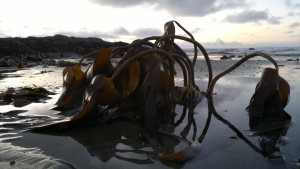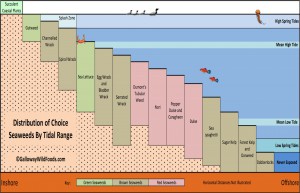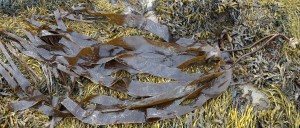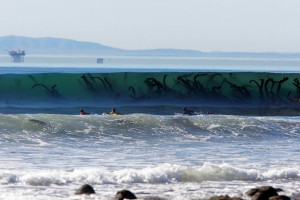Forest Kelp and Oarweed – Edibility, Identification, Distribution
Forest kelp – Laminaria hyperborea
Oarweed – Laminaria digitata
Both these species, and sugar kelp, are often referred to just as “kelp”, or colloquially as “tangle”
Related pages:
Habitat: Only at and (more often) below the mean low tide line. You will have to closely consult your tide tables if you want to harvest these without wading. Both species form dense and ecologically important subaquatic forests around our coasts.
Identification: Both species are large brown to golden brown seaweeds up to 3m long, with flat, finger-like fronds extending from a narrow stem (technically known as a meristem). The best way to distinguish between the two, is by the flattened stem of oarweed that flops limp when exposed, compared to the round, solid stems of forest kelp that remain upright even when exposed at extreme low tides.
Edible Uses: Unless you harvest young, immature fronds, both these laminaria species are generally too tough to eat raw or as a vegetable. The best treatment is to dry them, then eat the blades as crisps, or add them to soups and stocks to impart body and depth of flavour. Larger pieces can be added to broths as you would a bay leaf, and removed before serving.They add depth, seasoning, nutrients and umami which help other flavours to shine. They contribute to a good dashi.
I enjoy the young stems sliced into disks and pickled. They do retain a fair amount of chewiness, but i’m not sure why chewiness is so often cited as a negative thing. I’ve had fun with my friends at Bruichladdich distillery, adding pieces of dried kelp to whisky and gently warming it until salinity, sweetness and umami are released.
Try using dried pieces instead of lasagne to make lasagne al kelpo!
Fat blades are also excellent for what I call sous mer or sous weed cooking – wrapping around foods to impart flavour and retain moisture as they cook. See here.
Harvest: Year round (tides permitting). Cut the blades above the meristem to allow rapid regrowth.
Related pages:
- Edible seaweed guide
- Introduction to foraging for seaweeds
- Sous Weed Cooking
- Recipe: Scottish dashi broth
- Recipe: How to make sushi with wild ingredients
- Wild Food Guide
- 10 wild foods in season now



